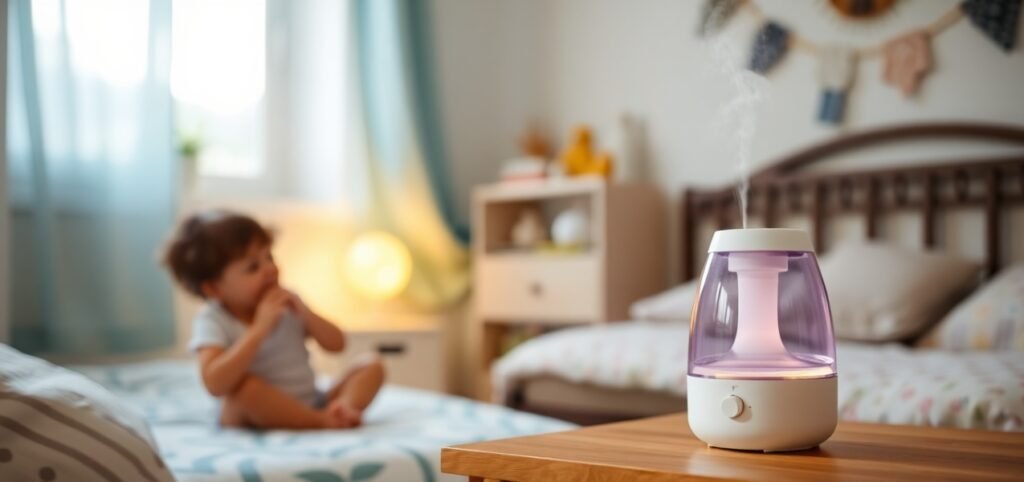If you’re a parent, you’ve probably heard that using a humidifier for baby can help with breathing, skin hydration, and overall comfort, especially during colder months. Humidifiers add moisture to the air, preventing dryness that can irritate your baby’s skin and airways. But using a humidifier safely and effectively requires some knowledge. In this beginner’s guide, we’ll walk you through 10 important tips to make sure you’re using a humidifier the right way.

1. Choose the Right Type of Humidifier
Before using a humidifier for baby, it’s essential to choose the right model. There are two main types: cool mist and warm mist humidifiers.
- Cool Mist: These are the safest option for babies, especially during sleep. They help maintain comfortable humidity levels without risking burns.
- Warm Mist: While this type can help soothe cold symptoms, it’s generally not recommended for babies because it may cause burns if touched.
Opt for a cool mist humidifier to keep your baby safe.
2. Keep the Humidifier Clean
One of the most important tips when using a humidifier for baby is cleanliness. A dirty humidifier can spread bacteria or mold into the air. Make sure to:
- Clean the humidifier at least once a week.
- Use warm water and mild soap to clean the tank.
- Let all parts dry completely before reassembling.
This will help prevent any harmful particles from circulating in your baby’s room.
3. Set It Up in the Right Spot
Where you place the humidifier in your baby’s room is crucial. Here’s how to do it right:
- Place the humidifier at least 3 feet away from your baby’s crib to prevent direct exposure.
- Avoid placing it near the baby’s face or in areas where it could tip over.
- Ensure that the mist isn’t directed directly at walls, fabrics, or furniture to avoid moisture buildup.
By setting it up correctly, you can ensure the humidifier works efficiently without causing any safety hazards.
4. Maintain Optimal Humidity Levels
Humidifiers are most effective when the humidity level in the room is between 40% and 60%. Too much humidity can lead to mold growth, while too little humidity won’t help your baby’s skin or airways.
- Use a hygrometer to monitor the room’s humidity levels.
- If the humidity goes above 60%, turn the humidifier off for a while or adjust it.
- You can also use a timer to regulate the humidity during the night.
Maintaining the right balance ensures your baby stays comfortable and healthy.
5. Keep the Room Ventilated
While using a humidifier for baby, it’s important to maintain proper air circulation. A well-ventilated room allows the humidified air to distribute evenly, which reduces the risk of mold and ensures better air quality.
- Open a window slightly during the day to allow fresh air in.
- Make sure there’s enough airflow from the room’s vent or fan.
Proper ventilation helps the humidifier work better and keeps your baby’s room comfortable.
6. Use Distilled Water
To avoid mineral buildup and improve the performance of your humidifier, always use distilled water instead of tap water. Tap water contains minerals that can create white dust when released into the air, which may irritate your baby’s respiratory system.
- Using distilled water keeps the air cleaner and reduces the need for frequent cleaning.
- Distilled water also prevents mineral deposits from clogging your humidifier.
By choosing distilled water, you’re ensuring your baby breathes in cleaner, safer air.
7. Avoid Adding Essential Oils
Essential oils may seem like a natural solution to freshen the air, but they aren’t recommended for babies. Some oils, like eucalyptus and peppermint, can cause respiratory distress or allergic reactions in infants.
- Never add essential oils directly to your baby’s humidifier.
- If you want to use a scent, choose one designed specifically for use in humidifiers, and consult with your pediatrician first.
For your baby’s safety, keep essential oils away from the humidifier.
8. Monitor the Humidifier Regularly
Another essential tip for using a humidifier for baby is to monitor it regularly to ensure it’s functioning properly. If the humidifier runs out of water or becomes clogged, it can stop working or release dry air, which defeats its purpose.
- Check the water level frequently, especially if the humidifier runs all night.
- Ensure the humidifier is still emitting mist by observing the airflow.
By keeping an eye on the humidifier, you can ensure it’s doing its job without any issues. (humidifier for baby)
9. Turn It Off When Not Needed
Using a humidifier for baby is great for when the air is dry, but it’s not always necessary. Running a humidifier constantly can lead to excess moisture, which could promote mold growth.
- Turn off the humidifier when the humidity level is in the ideal range.
- You can also use a timer to turn off the humidifier during sleep.
This helps prevent any negative side effects of over-humidifying the room. (humidifier for baby)
10. Consider a Humidifier with a Filter
Finally, when choosing a humidifier for your baby, consider one with a built-in filter. These filters help remove any harmful particles from the air, ensuring that the air your baby breathes is as clean as possible.
- Look for models with HEPA filters or carbon filters.
- Regularly replace the filter according to the manufacturer’s instructions.
A filter ensures cleaner air and adds an extra layer of protection for your baby’s health.
Conclusion: Using a Humidifier for Baby Safely
Using a humidifier for baby can greatly improve the air quality in your little one’s room and promote better sleep, breathing, and skin hydration. By following these 10 tips, you’ll ensure that the humidifier is working safely and effectively. Always remember to choose the right model, maintain it properly, and monitor humidity levels. With these steps, you can create a comfortable and healthy environment for your baby to thrive in.
